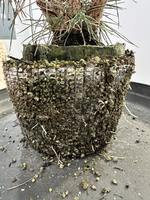Fake News! Not true in my experience. Uv is an issue after three years in my climate. Color change and more brittle. They cost $1 and serve their purpose until a larger size pond basket or an Anderson flat is needed. They do not cause roots to circle, they do air prune roots effectively! The caveat being that I am using inorganic free draining mix with all my containers. They do need carful watering due to the free drainage. You can get a better deal from the dollar store if you purchase by the case. The type I use come 48 per case and I have successfully used them for decades to raise pines. One year on the bench to establish root form and then set them for three years in the grow beds, Simple matter to cut off escaping roots and retain the core root ball. This method matches the seedling radial cutting process and develops even nebari from the outset. They are cheap, ugly and break down. But they work for their intended purpose which is to create better shape and type of roots from the outset to improve the overall outcome. ( assorted applications pictured below post
)
View attachment 380307View attachment 380308View attachment 380309View attachment 380310View attachment 380311View attachment 380312View attachment 380313
For deeper root balls and longer periods of air pruning the pond baskets are an improvement over colanders. They also stand up better under UV, typical useful like of ten years in my experience. Higher cost so they are not a cheaper alternative than colanders. I use these primarily for species that need deeper substrate and benefit from a larger container. Examples would be Chojubai, Prunus Mume, Toyo Nishiki.
View attachment 380314
Terra cotta can be used but does hold more moisture and cracks if climate is colder. It helps to use terra cotta that has been produced with more care and higher temperatures. I have had best experience with " Deroma" brand from Italy. They also come in a more advantageous shape shorter and wider for developing bonsai root balls. Typically referred to as Azalea pots or bulb pots. Terra cotta must be watered carefully as they stay wet for much longer periods of time. Easily develop algae on the outside and keep the roots too wet unless allowed to dry out between waterings. Actually the terra cotta holds the moisture longer and the inorganic mix can dry out before the terra cotta making it difficult to judge water levels within the pot. I do not recommend them for pines for this reason. I prefer them for deciduous that are ok with more continuous damp conditions. Great for establishing dwarf maples, Azalea, Zelkova, hornbeam, persimmon. I find it best to drill additional drainage holes and cut slots to improve drainage in terra cotta
View attachment 380315
Anderson Flats have the disadvantage of drainage impeded when put on a flat non porous surface. best to drill a few holes low down on the side to allow drainage when placed on a solid surface. The alternative I choose is to set them on a rougher or slotted surface. Typically a larger size gravel base.
I find these ideal for Pines and also Maples due to their shape and size. Have to adjust the soil mix to retain appropriate levels of moisture for the species.
The side holes really help drainage and they can be nest for additional drainage in special situations.
View attachment 380317
Note: all of these containers are used for development purposes and I am not suggesting them as replacements for Bonsai pots once the trees are finishing development and entering refinement.
















